

Compact Muon Solenoid
LHC, CERN
| CMS-PAS-HIN-18-014 | ||
| Measurement of Jet Nuclear Modification Factor in PbPb Collisions at √sNN= 5.02 TeV with CMS | ||
| CMS Collaboration | ||
| November 2019 | ||
| Abstract: High transverse momentum jet production in PbPb and pp collisions at a nucleon-nucleon center-of-mass energy of 5.02 TeV was studied with the CMS detector at the LHC, using a PbPb (pp) data sample corresponding to an integrated luminosity of 404 μb−1 (27.4 pb−1). Jets are reconstructed using the anti-kt algorithm with 5 radius parameters R between 0.2 and 1.0. The measurements are performed using jets with transverse momentum greater than 200 GeV and in a pseudorapidity window of |η|< 2. To reveal the medium modification of the jet spectra in PbPb collisions, jet nuclear modification factors (RAA) are extracted as functions of the PbPb collision centrality and the jet radius parameter. The dependence of jet suppression on R is expected to be sensitive to both the jet energy loss mechanism and also the medium response. These results are also compared to predictions from quenched jet event generators, theoretical models and analytical calculations. | ||
|
Links:
CDS record (PDF) ;
CADI line (restricted) ;
These preliminary results are superseded in this paper, JHEP 05 (2021) 284. The superseded preliminary plots can be found here. |
||
| Figures | |
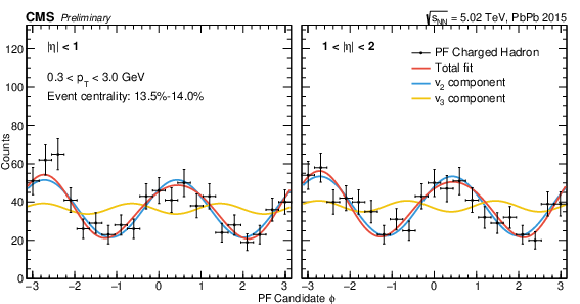
png pdf |
Figure 1:
Azimuthal angle distributions for a single PbPb event: ϕ modulations at mid-rapidity |η|< 1 (left) and forward rapidity 1 <|η|< 2 (right) of charged hadron particle-flow candidates. The v2 (blue curve) and v3 (yellow curve) of the flow components are shown, together with the total modulation used in the analysis to account for the background (red curve). |
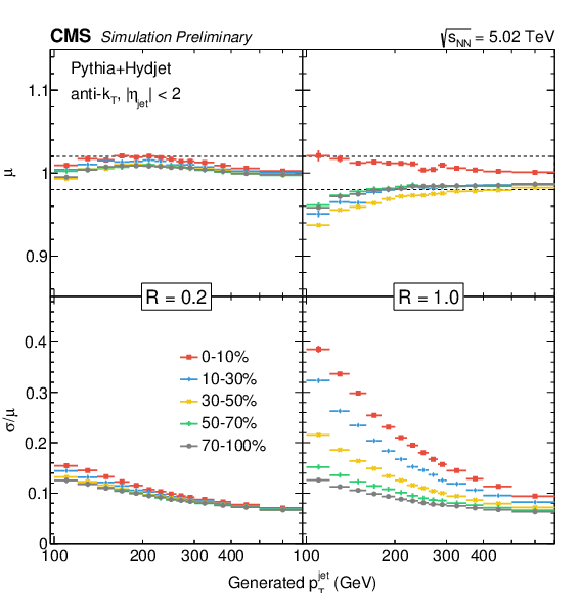
png pdf |
Figure 2:
The jet energy scale (top) and resolution (bottom) for an anti-kT jet with R= 0.2 (left) and R= 1.0 (right), and |ηjet|< 2, for different centrality classes. |
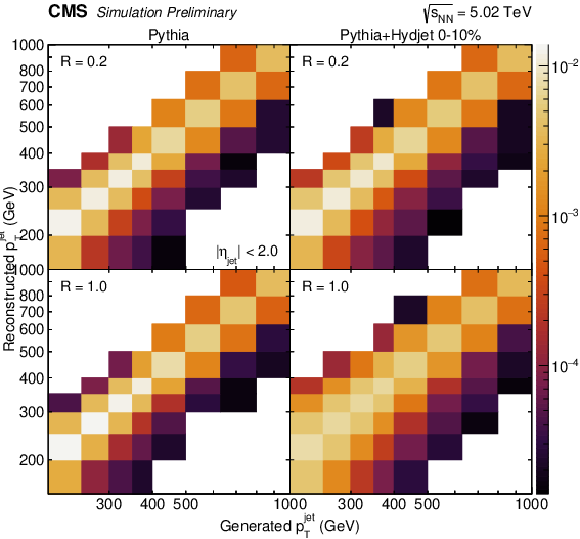
png pdf |
Figure 3:
Response matrix in PYTHIA (left) and PYTHIA + HYDJET 0-10% PbPb (right) events for jet R= 0.2 (top), R= 1.0 (bottom) and |ηjet|< 2. The integral for each generated pjetT bin is normalized to unity. |
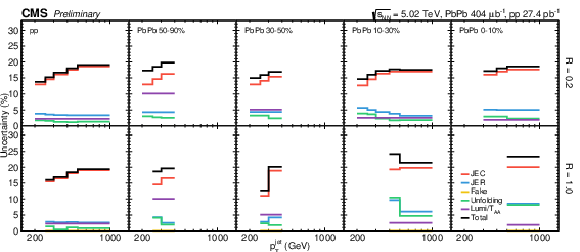
png pdf |
Figure 4:
The relative systematic uncertainty for measured jet spectra, in pp collisions (left-most panels), and PbPb collisions with centrality classes 50-90%, 30-50%, 10-30%, and 0-10% (right-most panel), for an anti-kT jet with R= 0.2 (top) and R= 1.0 (bottom) and |ηjet|< 2.0. |
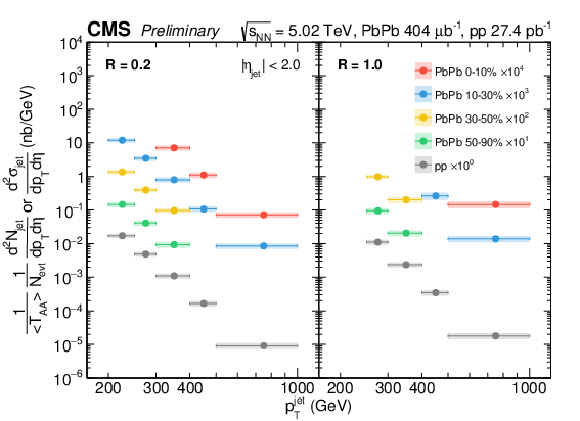
png pdf |
Figure 5:
The jet spectra for R= 0.2 (left) and R= 1.0 (right), for pp collisions and different centrality classes of PbPb collisions. The central values of different centrality classes are multiplied by factors of 10 for better separation. The statistical uncertainties are represented as vertical lines (smaller than marker size), while the systematic uncertainties is shown as shaded boxes. The markers are placed at the center of the bin. |
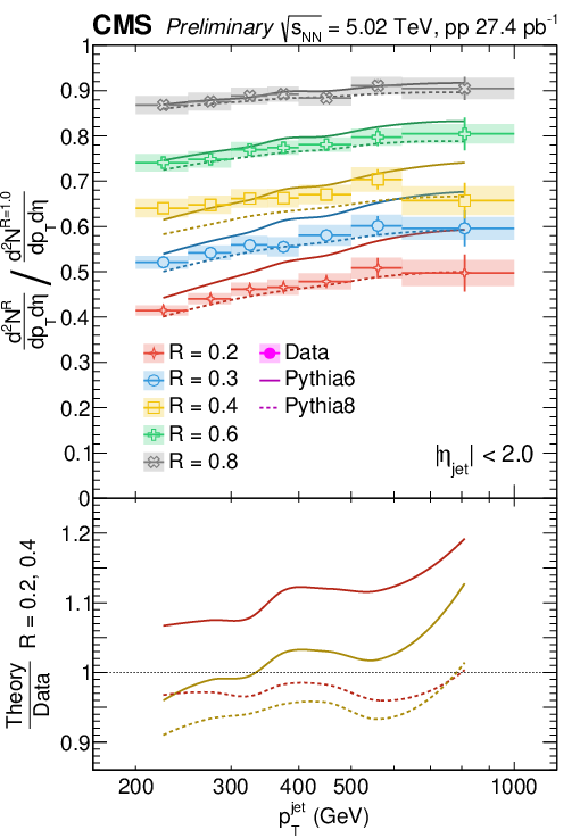
png pdf |
Figure 6:
The spectra ratio for jets for R= 0.2-0.8 with respect to R= 1.0. The statistical uncertainty on data are shown as vertical lines, whereas the systematic uncertainties are shown as shaded boxes. Markers for data are placed at the center of the bin. Comparisons with PYTHIA6 (solid line) and PYTHIA8 (dotted line) are plotted, along with ratios in the bottom panel for R= 0.2 and R= 0.4. |
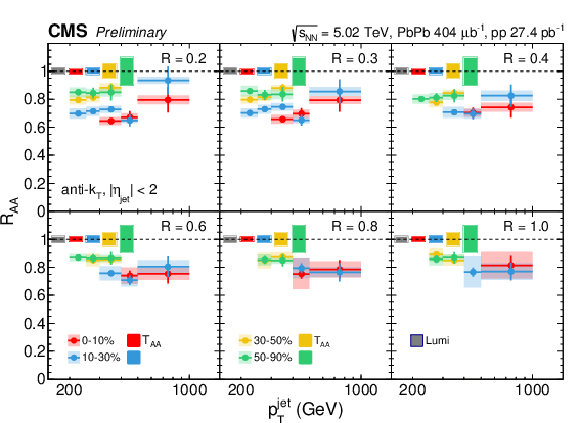
png pdf |
Figure 7:
The RAA for jets as a function of pjetT for various R and centrality classes. The statistical uncertainty is represented as a vertical line, while the systematic uncertainty is shown as a shaded box. The marker is placed at the center of the bin. Global uncertainties (luminosity for pp and TAA for PbPb) are shown as colored boxes on the dashed line at RAA= 1. |
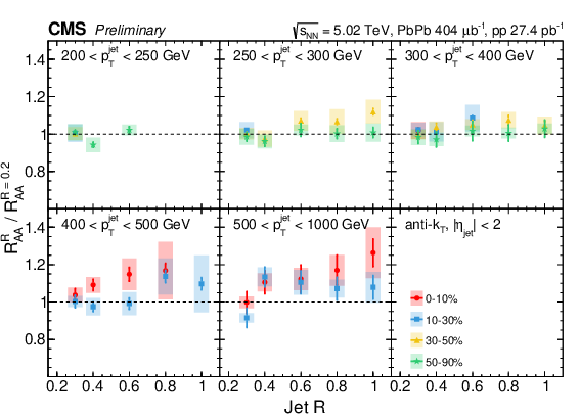
png pdf |
Figure 8:
The RAA-ratio for jets as a function of R for R=0.3− 1.0 with respect to R= 0.2, in various event centrality classes and pjetT ranges. The statistical uncertainty on data are shown as vertical lines, whereas the systematic uncertainties are shown as shaded boxes. The width of the boxes carry no meaning. |
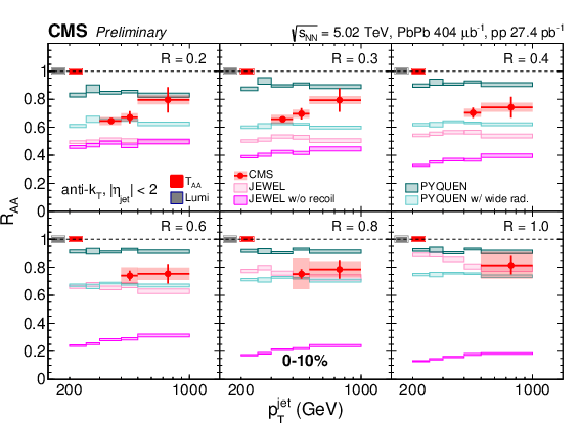
png pdf |
Figure 9:
The RAA for jets as a function of pjetT for various R and 0-10% centrality class. The statistical uncertainty is represented as a vertical line, while the systematic uncertainty is shown as a shaded box. The marker is placed at the center of the bin. Global uncertainties (luminosity for pp and TAA for PbPb) are shown as colored boxes on the dashed line at RAA= 1. Data is compared to predictions from Jewel (orange and purple) and PYQUEN (teal and green) generators as colored boxes. |
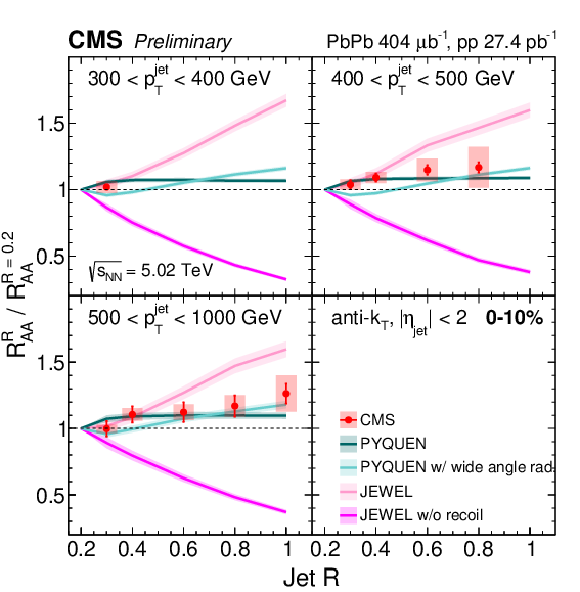
png pdf |
Figure 10:
The RAA-ratio for jets as a function of R for R=0.3− 1.0 with respect to R= 0.2, in various pjetT ranges for the 0-10% centrality class. The statistical uncertainty on data are shown as vertical lines, whereas the systematic uncertainties are shown as shaded boxes. The width of the boxes carry no meaning. Data is compared to predictions from Jewel (orange and purple) and PYQUEN (teal and green) generators as colored bands. |
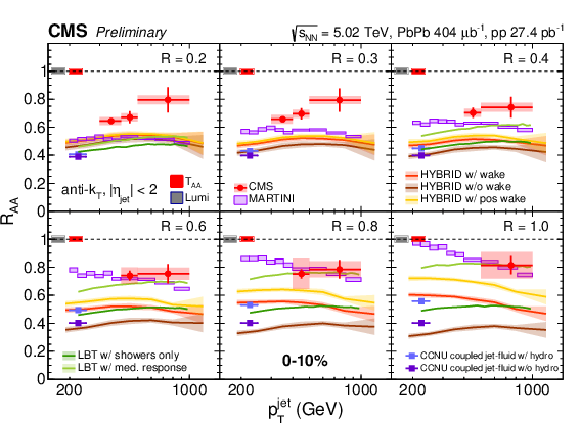
png pdf |
Figure 11:
The RAA for jets as a function of pjetT for various R and 0-10% centrality class. The statistical uncertainty is represented as a vertical line, while the systematic uncertainty is shown as a shaded box. The marker is placed at the center of the bin. Global uncertainties (luminosity for pp and TAA for PbPb) are shown as colored boxes on the dashed line at RAA= 1. Data is compared to predictions from HYBRID (pink, dark red and yellow), MARTINI (purple) and LBT (light and dark green) as colored boxes and bands. |
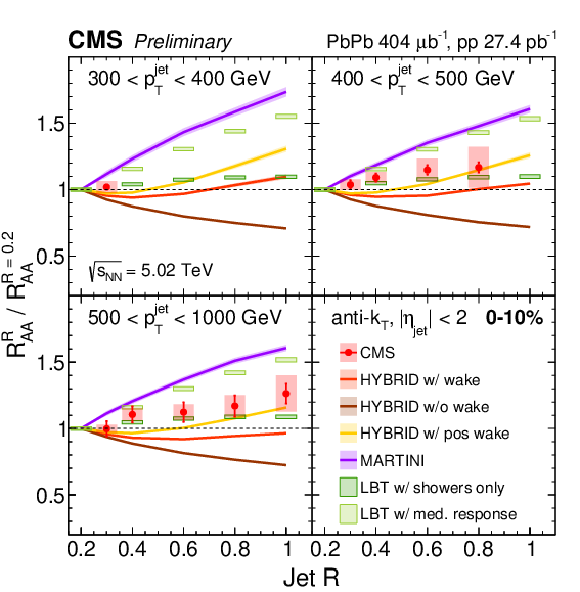
png pdf |
Figure 12:
The RAA-ratio for jets as a function of R for R=0.3− 1.0 with respect to R= 0.2, in various pjetT ranges for the 0-10% centrality class. The statistical uncertainty on data are shown as vertical lines, whereas the systematic uncertainties are shown as shaded boxes. The width of the boxes carry no meaning. Data is compared to predictions from HYBRID (pink, dark red and yellow), MARTINI (purple) and LBT (light and dark green) as colored bands. |

png pdf |
Figure 13:
The RAA for jets as a function of pjetT for various R and 0-10% centrality class. The statistical uncertainty is represented as a vertical line, while the systematic uncertainty is shown as a shaded box. The marker is placed at the center of the bin. Global uncertainties (luminosity for pp and TAA for PbPb) are shown as colored boxes on the dashed line at RAA= 1. Data is compared to calculations from SCETG (purple and teal) and jet factorization (grey) formalisms as colored areas. |
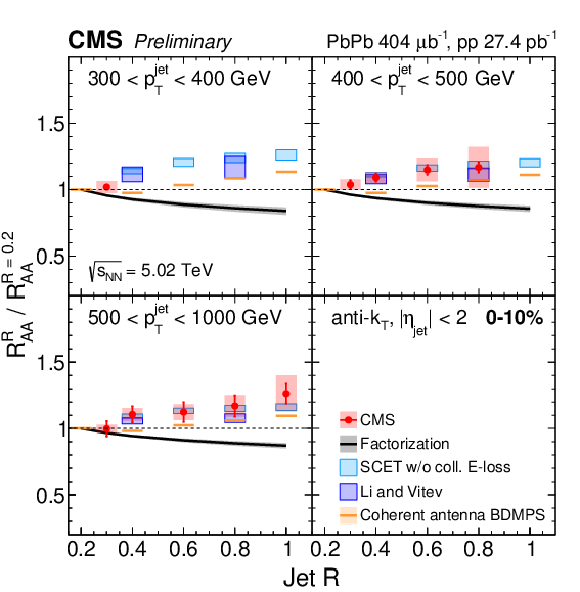
png pdf |
Figure 14:
The RAA-ratio for jets as a function of R for R= 0.3-1.0 with respect to R= 0.2, in various pjetT ranges for the 0-10% centrality class. The statistical uncertainty on data are shown as vertical lines, whereas the systematic uncertainties are shown as shaded boxes. The width of the boxes carry no meaning. Data is compared to calculations based from SCETG (purple and teal) and jet factorization (grey) formalism's as colored areas. |
| Tables | |
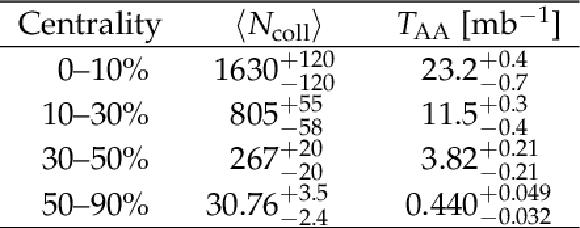
png pdf |
Table 1:
The values of <Ncoll> and TAA and their uncertainties in √sNN= 5.02 TeV PbPb collisions for the centrality ranges used in this analysis [45]. |
| Summary |
| Measurements of jet nuclear modification factors based on pp and PbPb collisions at √sNN= 5.02 TeV are presented. For the first time, jet spectra measurements are extended to large radius jet with radius parameter R up to 1.0. A strong suppression of high pT jets reconstructed with all jet radius parameters is observed in the most central collisions. Those results are compared to various predictions from quenched jet event generators, theoretical models and analytical calculations. While all the theoretical models which gave a reasonable description of the RAA of jets reconstructed with small jet radius, they predict a wide range of jet RAA at large radius. The new data place new constraints on the underlying jet quenching mechanisms. |
| References | ||||
| 1 | F. Karsch | The phase transition to the quark gluon plasma: recent results from lattice calculations | NP A 590 (1995) 367 | hep-lat/9503010 |
| 2 | J. D. Bjorken | Highly relativistic nucleus-nucleus collisions: The central rapidity region | PRD 27 (1983) 140 | |
| 3 | J. E. Bernhard et al. | Applying Bayesian parameter estimation to relativistic heavy-ion collisions: simultaneous characterization of the initial state and quark-gluon plasma medium | PRC94 (2016), no. 2, 024907 | 1605.03954 |
| 4 | J. D. Bjorken | Energy Loss of Energetic Partons in Quark - Gluon Plasma: Possible Extinction of High p(t) Jets in Hadron-Hadron Collisions | FERMILAB-PUB-82-059-THY | |
| 5 | M. Gyulassy and M. Plumer | Jet quenching in dense matter | PLB 243 (1990) 432 | |
| 6 | X.-N. Wang and M. Gyulassy | Gluon shadowing and jet quenching in A+A collisions at √s=200A GeV | PRL 68 (1992) 1480 | |
| 7 | R. Baier et al. | Radiative energy loss and p⊥-broadening of high energy partons in nuclei | NPB 484 (1997) 265 | hep-ph/9608322 |
| 8 | B. G. Zakharov | Radiative energy loss of high-energy quarks in finite-size nuclear matter and quark-gluon plasma | JEPTL 65 (1997) 615 | hep-ph/9704255 |
| 9 | D. A. Appel | Jets as a probe of quark-gluon plasmas | PRD 33 (1986) 717 | |
| 10 | J. P. Blaizot and L. D. McLerran | Jets in expanding quark-gluon plasmas | PRD 34 (1986) 2739 | |
| 11 | JET Collaboration | Extracting the jet transport coefficient from jet quenching in high-energy heavy-ion collisions | PRC 90 (2014) 014909 | 1312.5003 |
| 12 | H. Liu, K. Rajagopal, and U. A. Wiedemann | Calculating the jet quenching parameter from AdS/CFT | PRL 97 (2006) 182301 | hep-ph/0605178 |
| 13 | J. Casalderrey-Solana and C. A. Salgado | Introductory lectures on jet quenching in heavy ion collisions | Acta Phys. Polon. B 38 (2007) 3731 | 0712.3443 |
| 14 | D. d'Enterria | Jet quenching | in Springer Materials - The Landolt-B\"ornstein Database, R. Stock, ed., volume 23: Relativistic Heavy Ion Physics, p. 99 Springer-Verlag | 0902.2011 |
| 15 | U. A. Wiedemann | Jet quenching in heavy ion collisions | Landolt-Bornstein (2010) 521 | 0908.2306 |
| 16 | A. Majumder and M. Van Leeuwen | The theory and phenomenology of perturbative QCD based jet quenching | Prog. Part. NP 66 (2011) 41 | 1002.2206 |
| 17 | PHENIX Collaboration | Formation of dense partonic matter in relativistic nucleus-nucleus collisions at RHIC: Experimental evaluation by the PHENIX collaboration | NP A757 (2005) 184--283 | nucl-ex/0410003 |
| 18 | STAR Collaboration | Experimental and theoretical challenges in the search for the quark gluon plasma: The STAR Collaboration's critical assessment of the evidence from RHIC collisions | NP A757 (2005) 102--183 | nucl-ex/0501009 |
| 19 | B. B. Back et al. | The PHOBOS perspective on discoveries at RHIC | NP A757 (2005) 28--101 | nucl-ex/0410022 |
| 20 | BRAHMS Collaboration | Quark gluon plasma and color glass condensate at RHIC? The Perspective from the BRAHMS experiment | NP A757 (2005) 1--27 | nucl-ex/0410020 |
| 21 | CMS Collaboration | Study of high-pT charged particle suppression in PbPb compared to pp collisions at √sNN= 2.76 TeV | EPJC72 (2012) 1945 | CMS-HIN-10-005 1202.2554 |
| 22 | ATLAS Collaboration | Measurement of charged-particle spectra in Pb+Pb collisions at √sNN= 2.76 TeV with the ATLAS detector at the LHC | JHEP 09 (2015) 050 | 1504.04337 |
| 23 | ALICE Collaboration | Suppression of Charged Particle Production at Large Transverse Momentum in Central Pb-Pb Collisions at √sNN= 2.76 TeV | PLB696 (2011) 30--39 | 1012.1004 |
| 24 | ATLAS Collaboration | Measurements of the nuclear modification factor for jets in Pb+Pb collisions at √sNN= 2.76 TeV with the ATLAS detector | PRL 114 (2015) 072302 | 1411.2357 |
| 25 | ALICE Collaboration | Measurement of jet suppression in central Pb-Pb collisions at √sNN= 2.76 TeV | PLB 746 (2015) 1 | 1502.01689 |
| 26 | CMS Collaboration | Measurement of inclusive jet cross sections in pp and PbPb collisions at √sNN= 2.76 TeV | PRC 96 (2017) 015202 | CMS-HIN-13-005 1609.05383 |
| 27 | CMS Collaboration | Studies of jet quenching using isolated-photon+jet correlations in PbPb and pp collisions at √sNN= 2.76 TeV | PLB 718 (2013) 773 | CMS-HIN-11-010 1205.0206 |
| 28 | CMS Collaboration | Study of jet quenching with isolated-photon+jet correlations in PbPb and pp collisions at √sNN= 5.02 TeV | PLB785 (2018) 14--39 | CMS-HIN-16-002 1711.09738 |
| 29 | CMS Collaboration | Measurement of jet fragmentation in PbPb and pp collisions at √sNN= 2.76 TeV | PRC 90 (2014) 024908 | CMS-HIN-12-013 1406.0932 |
| 30 | ATLAS Collaboration | Measurement of jet fragmentation in Pb+Pb and pp collisions at √sNN= 2.76 TeV with the ATLAS detector at the LHC | EPJC 77 (2017) 379 | 1702.00674 |
| 31 | CMS Collaboration | Observation of medium induced modifications of jet fragmentation in PbPb collisions using isolated-photon-tagged jets | CMS-HIN-16-014 1801.04895 |
|
| 32 | ATLAS Collaboration | Observation of a centrality-dependent dijet asymmetry in lead-lead collisions at √sNN= 2.76 TeV with the ATLAS detector at the LHC | PRL 105 (2010) 252303 | 1011.6182 |
| 33 | CMS Collaboration | Observation and studies of jet quenching in PbPb collisions at √sNN= 2.76 TeV | PRC 84 (2011) 024906 | CMS-HIN-10-004 1102.1957 |
| 34 | CMS Collaboration | Measurement of transverse momentum relative to dijet systems in PbPb and pp collisions at √sNN= 2.76 TeV | JHEP 01 (2016) 006 | CMS-HIN-14-010 1509.09029 |
| 35 | CMS Collaboration | Decomposing transverse momentum balance contributions for quenched jets in PbPb collisions at √sNN= 2.76 TeV | JHEP 11 (2016) 055 | CMS-HIN-15-011 1609.02466 |
| 36 | CMS Collaboration | Modification of jet shapes in PbPb collisions at √sNN= 2.76 TeV | PLB 730 (2014) 243 | CMS-HIN-12-002 1310.0878 |
| 37 | Y.-T. Chien and I. Vitev | Towards the understanding of jet shapes and cross sections in heavy ion collisions using soft-collinear effective theory | JHEP 05 (2016) 023 | 1509.07257 |
| 38 | N. Armesto, L. Cunqueiro, and C. A. Salgado | Q-PYTHIA: A Medium-modified implementation of final state radiation | EPJC63 (2009) 679--690 | 0907.1014 |
| 39 | Y. Tachibana, N.-B. Chang, and G.-Y. Qin | Full jet in quark-gluon plasma with hydrodynamic medium response | PRC95 (2017), no. 4, 044909 | 1701.07951 |
| 40 | Z. Hulcher, D. Pablos, and K. Rajagopal | Resolution Effects in the Hybrid Strong/Weak Coupling Model | 1707.05245 | |
| 41 | M. L. Miller, K. Reygers, S. J. Sanders, and P. Steinberg | Glauber modeling in high energy nuclear collisions | Ann. Rev. Nucl. Part. Sci. 57 (2007) 205 | nucl-ex/0701025 |
| 42 | CMS Collaboration | The CMS experiment at the CERN LHC | JINST 3 (2008) S08004 | CMS-00-001 |
| 43 | CMS Collaboration | Charged-particle nuclear modification factors in PbPb and pPb collisions at √sNN= 5.02 TeV | JHEP 04 (2017) 039 | CMS-HIN-15-015 1611.01664 |
| 44 | CMS Collaboration | Transverse Momentum and Pseudorapidity Distributions of Charged Hadrons in pp Collisions at √s= 0.9 and 2.36 TeV | JHEP 02 (2010) 041 | CMS-QCD-09-010 1002.0621 |
| 45 | C. Loizides, J. Kamin, and D. d'Enterria | Improved Monte Carlo Glauber predictions at present and future nuclear colliders | PRC97 (2018), no. 5, 054910 | 1710.07098 |
| 46 | T. Sjostrand et al. | An Introduction to PYTHIA 8.2 | CPC 191 (2015) 159 | 1410.3012 |
| 47 | CMS Collaboration | Event generator tunes obtained from underlying event and multiparton scattering measurements | EPJC 76 (2016) 155 | CMS-GEN-14-001 1512.00815 |
| 48 | I. P. Lokhtin and A. M. Snigirev | A model of jet quenching in ultrarelativistic heavy ion collisions and high-pT hadron spectra at RHIC | EPJC 45 (2006) 211 | hep-ph/0506189 |
| 49 | GEANT4 Collaboration | GEANT4 --- a simulation toolkit | NIMA 506 (2003) 250 | |
| 50 | CMS Collaboration | Particle-flow reconstruction and global event description with the CMS detector | JINST 12 (2017) P10003 | CMS-PRF-14-001 1706.04965 |
| 51 | M. Cacciari, G. P. Salam, and G. Soyez | The anti-kt jet clustering algorithm | JHEP 04 (2008) 063 | 0802.1189 |
| 52 | M. Cacciari, G. P. Salam, and G. Soyez | FastJet user manual | EPJC 72 (2012) 1896 | 1111.6097 |
| 53 | O. Kodolova, I. Vardanian, A. Nikitenko, and A. Oulianov | The performance of the jet identification and reconstruction in heavy ions collisions with CMS detector | EPJC 50 (2007) 117 | |
| 54 | CMS Collaboration | Jet momentum dependence of jet quenching in PbPb collisions at √sNN= 2.76 TeV | PLB 712 (2012) 176 | CMS-HIN-11-013 1202.5022 |
| 55 | CMS Collaboration | Measurement of the elliptic anisotropy of charged particles produced in PbPb collisions at √sNN= 2.76 TeV | PRC87 (2013), no. 1, 014902 | CMS-HIN-10-002 1204.1409 |
| 56 | CMS Collaboration | Study of jet quenching with Z+jet correlations in PbPb and pp collisions at √sNN= 5.02 TeV | PRL 119 (2017) 082301 | |
| 57 | P. Berta, M. Spousta, D. W. Miller, and R. Leitner | Particle-level pileup subtraction for jets and jet shapes | JHEP 06 (2014) 092 | 1403.3108 |
| 58 | CMS Collaboration | Jet energy scale and resolution in the CMS experiment in pp collisions at 8 TeV | JINST 12 (2017) P02014 | CMS-JME-13-004 1607.03663 |
| 59 | T. Adye | Unfolding algorithms and tests using RooUnfold | in Proceedings, PHYSTAT 2011 Workshop on Statistical Issues Related to Discovery Claims in Search Experiments and Unfolding, CERN 2011 | 1105.1160 |
| 60 | CMS Collaboration | CMS luminosity calibration for the pp reference run at √s= 5.02 TeV | CMS-PAS-LUM-16-001 | |
| 61 | CMS Collaboration | Measurement of inclusive jet cross sections in pp and pbpb collisions at √sNN= 2.76 tev | PRC 96 (Jul, 2017) 015202 | |
| 62 | K. C. Zapp | Jewel 2.0.0: directions for use | The European Physical Journal C 74 (2014) 1--14 | |
| 63 | D. Pablos | Jet suppression from small to intermediate to large radius | 2019 | |
| 64 | Y. He et al. | Interplaying mechanisms behind single inclusive jet suppression in heavy-ion collisions | PRC99 (2019), no. 5, 054911 | 1809.02525 |
| 65 | N.-B. Chang and G.-Y. Qin | Full jet evolution in quark-gluon plasma and nuclear modification of jet production and jet shape in Pb+Pb collisions at 2.76ATeV at the CERN Large Hadron Collider | PRC94 (2016), no. 2, 024902 | 1603.01920 |
| 66 | N.-B. Chang, Y. Tachibana, and G.-Y. Qin | Nuclear modification of jet shape for inclusive jets and γ-jets at the LHC energies | 1906.09562 | |
| 67 | B. Schenke, C. Gale, and S. Jeon | MARTINI: An Event generator for relativistic heavy-ion collisions | PRC80 (2009) 054913 | 0909.2037 |
| 68 | J.-W. Qiu, F. Ringer, N. Sato, and P. Zurita | Factorization of jet cross sections in heavy-ion collisions | Physical Review Letters 122 (Jun, 2019) | |
| 69 | R. Baier, Y. L. Dokshitzer, S. Peigne, and D. Schiff | Induced gluon radiation in a QCD medium | PLB345 (1995) 277--286 | hep-ph/9411409 |
| 70 | J. Casalderrey-Solana, Y. Mehtar-Tani, C. A. Salgado, and K. Tywoniuk | New picture of jet quenching dictated by color coherence | PLB725 (2013) 357--360 | 1210.7765 |
| 71 | Y. Mehtar-Tani and K. Tywoniuk | Groomed jets in heavy-ion collisions: sensitivity to medium-induced bremsstrahlung | JHEP 04 (2017) 125 | 1610.08930 |
| 72 | H. T. Li and I. Vitev | Inclusive heavy flavor jet production with semi-inclusive jet functions: from proton to heavy-ion collisions | Journal of High Energy Physics 2019 (Jul, 2019) 148 | |

|
Compact Muon Solenoid LHC, CERN |

|

|

|

|

|

|